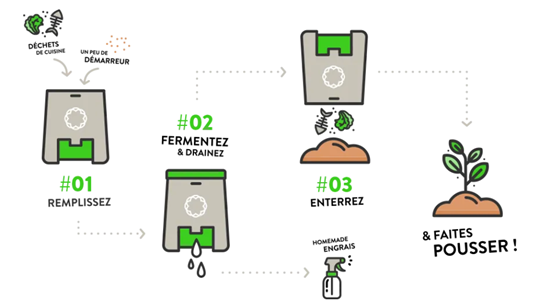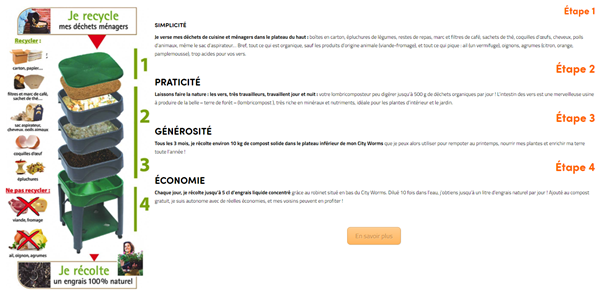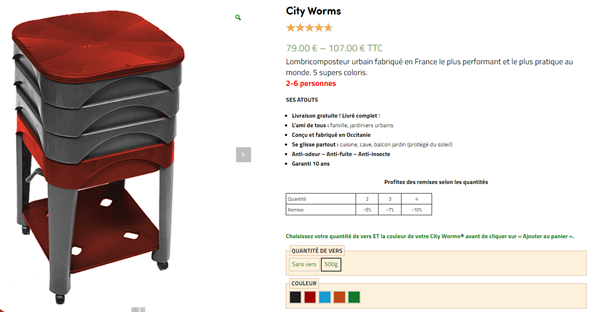 Carnet d’inspiration Naturia
Carnet d’inspiration Naturia
Le Compostage
Définition : la mise en fermentation de certains déchets agricoles ou urbains, de façon à récupérer des éléments riches en minéraux et matière organique, qui sont ensuite incorporés aux terres agricoles afin de les enrichir
Compostage individuel
1/Technique BOKASHI pour composter vos restes alimentaires sans vers, ni mouchettes, sans jardin, ni mauvaises odeurs
Le Bokashi compost en 8 Questions-réponses :


2/Vermicompostage avec l’intervention de vers
Un lombricomposteur est un outil bien pratique quand on veut réduire ses déchets et fertiliser ses plantes mais quand on n’a pas de jardin pour un grand bac à compost. Les verres avec qui vous allez faire équipe vont vous aider à réduire ces déchets en un compost et un thé très nutritif bien plus vite que dans un simple seau.
On vous détaille le fonctionnement d’un lombricomposteur sur cette page et on vous aide à choisir le meilleur appareil pour vous lancer ! Il en existe beaucoup aujourd’hui sur le marché et il vaut mieux être sûr de choisir la meilleure maison pour vos vers !
Petit film de 6 minutes :
www.lecomposteur.fr/city-worms


Compostage collectif
Le compostage est le recyclage des déchets organiques pour produire naturellement un fertilisant, le compost.
30% des déchets ménagers peuvent être compostés. Le compostage est à la fois écologique économique et pratique :
écologique : le compostage limite la quantité de déchets ;
économique : le compost est un engrais naturel et gratuit ;
pratique : il favorise et améliore la fertilité de votre jardin dans le temps.

Le principe du compostage collectif est simple :
Des bacs à compost sont installés sur une parcelle de terre réservée à cela.
L’initiative doit être appuyée par la collectivité (locataires, personnes de passage).
Cette démarche doit bénéficier d’un nombre minimum de participants (environ 10 foyers).
Une ou plusieurs personnes doivent surveiller le processus de transformation des déchets.
Comment fonctionne le compostage collectif ?
Le fonctionnement du compostage collectif comprend plusieurs phases
- récupération et stockage des déchets sous forme de tas,
- fermentation et retournement régulier du tas et des déchets,
- maturation et distribution du compost ainsi créé
Objectifs de ce compostage
Le compostage collectif a pour objectif de :
- réduire les déchets verts de la ville et les déchets ménagers des riverains,
- gérer les déchets dans la continuité du tri sélectif,
- créer un lien social.
Avantages du compostage collectif
- La coopérative met à disposition la structure et gère l’ensemble du processus de transformation des déchets.
- Vous réduisez vos ordures ménagères en les apportant sur le site dédié.
- Le processus de fermentation et de transformation est pris en charge par la coopérative.
- Le compost gratuit prêt à l’emploi.
Que peut-on composter?
Tous les déchets du jardin: tontes de gazon, feuilles mortes, fleurs fanées, tailles de haies et d’arbustes, copeaux de bois, mauvaises herbes, ainsi que les déchets de la maison: épluchures de légumes et de fruits, marc de café, sachets de thé, coquilles d’oeufs, cartons découpés, papier essuie-tout, litières de petits animaux herbivores.
Plus les déchets sont variés, plus le compost final sera riche. A éviter : les déchets d’origine animale. Interdit : les produits non biodégradables comme le plastique ou les ferrailles, ou contenant des polluants comme les textiles, colles et vernis, sciures de menuiserie, cendres de charbon, poussières d’aspirateurs.
Comment réussir son compost?
On démarre par une couche de branchages coupés pour favoriser la ventilation du compost. Puis on alterne les matières vertes et humides et les déchets bruns et secs par couches successives de 10 à 20cm, en apportant peu d’un même matériau à la fois. La quantité d’éléments verts doit être deux fois supérieure à celle des déchets secs.
Eviter de faire de gros apports d’un coup de tontes de gazon et les laisser sécher un peu au soleil avant de les introduire dans le compost. Arroser si nécessaire le compost pour le garder humide.
Si on composte en tas, on le retourne après deux mois pour favoriser la circulation de l’air et éviter les mauvaises odeurs. Quand on composte en fût, il faut mélanger les matières une fois par semaine en tournant une tige d’aération dans le compost.
Quand le compost est-il prêt?
Le processus dépend de la température extérieure. La décomposition est plus rapide en été et en automne, plus lente les autres saisons. Dans les premiers jours, le tas de déchets s’échauffe sous l’effet de l’action microbienne. La chaleur dégagée par le compost est une conséquence du bon fonctionnement. Elle est surtout fonction du volume de matières à composter.
La décomposition qui suit s’opère le mois suivant et s’accompagne d’un fort dégagement de gaz carbonique. Une odeur d’ammoniaque peut provenir d’une température trop élevée ou lorsqu’il y a trop de matières azotées (tontes de gazon) et pas assez d’air.
La phase de stabilisation démarre au bout de 2 à 3 mois. La micro-faune diversifiée donne au compost sa couleur sombre, son aspect grumeleux et son odeur de terreau forestier.
Au bout de 6 à 9 mois, le compost est prêt à être utilisé pour enrichir la terre des semis au potager, rempoter les plantes d’intérieur ou de balcon, bouturer ou planter les fleurs et buissons dans les massifs du jardin.
Où déposer votre compost à Naturia ?
Amenez vos déchets de jardin et vos déchets de maison (voir plus haut « Que peut-on composter ») aux bacs prévus à cet effet à côté du potager.